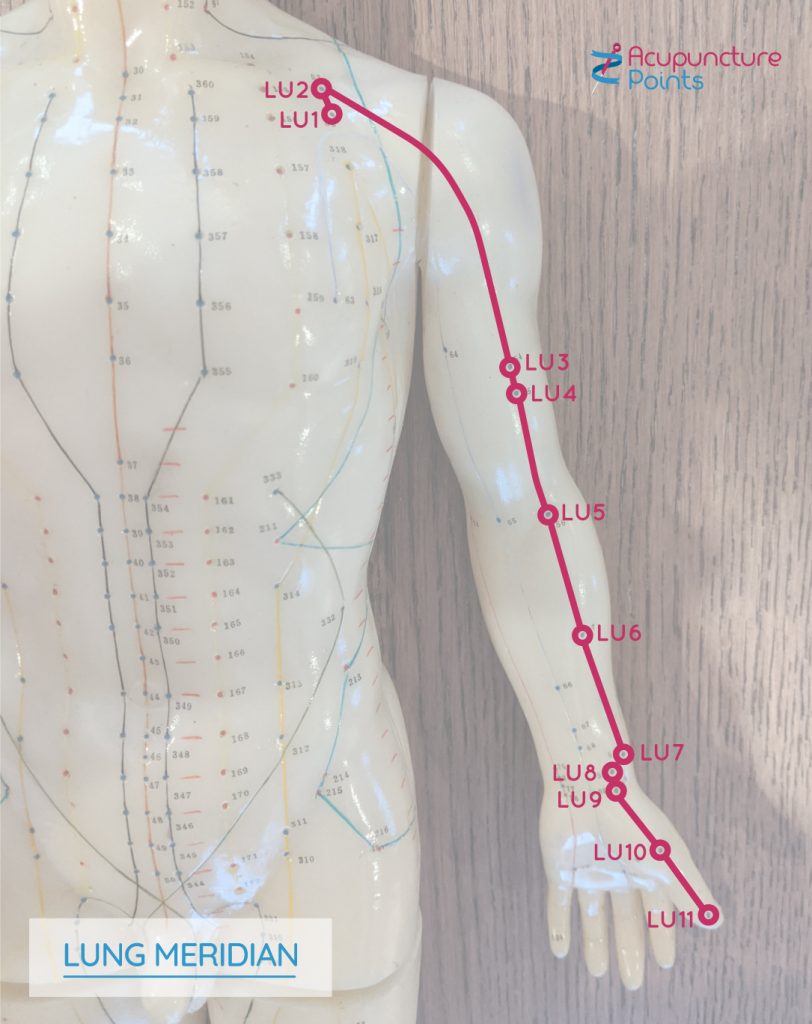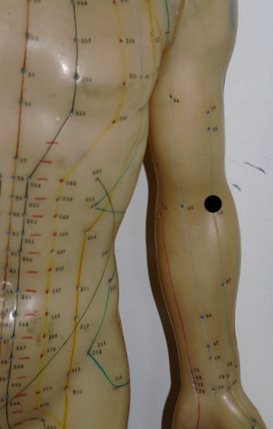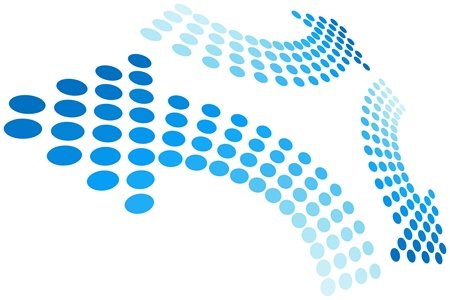
Heart and Kidney Yang deficiency
With Heart and Kidney Yang deficiency, you’ve overstressed your body’s ability to recover from over-exertion and cold.

Lung 5 is the fifth point along the Lung acupuncture channel. It is also:

On the elbow crease, up to 1 cun lateral to the biceps tendon in the depression. The point is often just lateral to the tendon, in the hollow formed when the arm is flexed at right angles.
The point Large Intestine 11 (Quchi) is adjacent, but at the lateral end of the elbow crease. Both points clear heat, but from different places, so it is important to needle the point correctly.
NB The Japanese locate this point somewhat lateral to the Chinese. One must feel for the location.
Some texts warn that the cubital vein runs nearby, but in practice I’ve never had a problem with this. Besides, the walls of both veins and arteries are quite tough so breaching them is, while not impossible, quite difficult.
Some texts caution against using moxa here.
Sensation: when needled correctly the sensation felt may be not just as heaviness at the point of the needle, but also sometimes like a mild electric reaction in the hand on that side.
Where the above actions are diagnosed for conditions such as:
Lung point 5 is adjacent at the elbow to Large Intestine 11. Both points clear heat, Lung 5 from the Lungs, Large Intestine 11 from the intestines and Blood. Using one needle technique for them together helps clear all heat downwards.
Most of the Actions and Indications are for symptoms of Fullness – for example of Phlegm or Heat but this point is highly effective in deficiency-heat syndromes.
(Until I write a page on ‘deficiency heat’ syndromes, they are syndromes where because of yin deficiency, you get symptoms which appear to be like Heat. However, they get better by strengthening Yin not by clearing Yang. If this is still moonshine to you (!), it may help to read Excess and Deficiency and then Yin Deficiency.)
For example, after many upper respiratory infections, such as ‘colds’, people are left with niggling coughs and perhaps a very slight sore throat, often more noticeable later in the day or evening. The cough may be worse on exertion indoors (which heats you up), or on entering warm rooms or when sitting near central heating or radiant fires, all of which produce warm or dry air. It may be somewhat better in cool air. These modalities suggest there is some remaining heat in the system, particularly the Lungs.
This is the usually the best point on the Lung channel for clearing this residual heat. You might think that dispersing the point would further weaken the patient whose energy may already be low from fighting off the infection. But actually, when you’ve cleared the heat, the whole system will function better, and the patient will recover faster.
Why? You can understand this with an analogy. If you have a boiler to heat your water, what happens when the boiler itself starts to overheat? First, fuel is being wasted because instead of heating the house you’re heating the boiler. Second, the boiler is less efficient so less heat reaches the house.
Applying the analogy to the Lungs, your Qi is wasted because it is being used to heat the Lungs, causing the cough and dryness, and so there is less energy for the house – meaning you feel low and take longer to recover.
Using this point either on its own (a powerful and elegant treatment) or with other points to support your intention, can produce fast results.
Many acupuncturists hammer away at tonifying treatments when actually they should clear old sources of heat or damp from the system. If that heat or phlegm is in the Lungs, this point may be exactly what is needed. THEN you can tonify, if you still need to.
I’ve noticed that this residual deficiency Lung heat doesn’t necessarily show up on the tongue or in the pulses, or if it does, it’s confused with something else.
For example, a slight redness towards the tongue-tip may be interpreted as the cause of a patient’s insomnia, causing treatment to be directed at the insomnia and not at the underlying Lung problem.
This residual Lung heat may go back to childhood illnesses which were never properly resolved by the body, being suppressed by medication at the time, causing years – indeed decades – of health problems, all of which were derived from this residual Lung heat.
But leave time for the point to work. Although the patient’s pulses may improve immediately during treatment, the body still has work to do and ‘re-setting’ the system with acupuncture is one thing, but allowing the body time to clear the heat or phlegm is another. It can take a day or two.
If treating someone concerned about skin health and beauty care, Lung 5 is often a good point to clear traces of heat in the system and help the lungs and blood moisturise the skin. Click here for more.
In extreme cases, you may also need to do cupping or GuaSha on the back to stimulate the Lungs to work harder.
Lung Point 5 is also one of the main points for regulating the water passages.
What is meant by ‘regulating the water passages’ when, in Western medicine, the kidneys and bladder do this?
The Lungs control the skin and perspiration, and every breath you take involves an exchange of water as well as of oxygen. If Lung qi is deficient, your body won’t manage the exchange of water needed here.
From the Chinese perspective, the Lungs descend qi, whereas Kidney yang raises it. (Actually, that’s not exactly what Kidney Yang does, but let’s say it does for the moment!)
Working together the Lungs and Kidneys manage the balance of water in the system.
Oedema in the body, especially in upper parts or on the face, (for example after sleep) suggest that the Lung/Kidney energy is imbalanced and that the Lung function of descending qi is weak.

This point helps clear that tendency to damp when it emanates from the Lungs.
Another pointer to the important relationship between Lungs and Kidneys is this. You may notice this when urination is being voluntarily delayed, (such as when you have a full bladder but can’t find anywhere to urinate) you often breathe more shallowly. When finally you do urinate, you often take a large, relaxing breath, not least to help release the sphincter muscle at the bladder.
The Lungs are also, via the 5 Phase/Element diagram, the Mother of the Kidneys. If Lung qi isn’t working properly, Kidney qi may not function. The reverse can also be true: when Kidney Qi is deficient, Lung function may suffer.
Frequent crying can indicate fullness in the Lungs, but so can deficient Lung qi: there is a saying that ‘where qi is weak, fluids leak’: fluids include lachrimation.
With the latter, lachrimation/crying occurs more often as the individual tires, whereas with Lung fullness, it can occur at any time, aggravated by strong light, emotions or heat.
It is also certainly possible to have both Lung fullness and Lung qi deficiency at the same time. In this case, disperse here at Chize, Lung point 5, and tonify elsewhere, for example at Lung point 9, Taiyuan, possibly with other points to back it up. However, even here, as I said at the start, sometimes all you need to do is to disperse Chize and allow the body to recover on its own.
Lung point 5 is (of course) on the Lung channel, which originates at CV12, Zhong Wan, deep in the upper abdomen near the stomach organ. When there is Stomach Heat, or obstruction of food as it passes through the digestive tract, this point often provides the extra push to clear the imbalance.
Also, from the Five Element point of view, dispersing the Lung qi is dispersing the energy of the Child of the Spleen/Stomach which has the effect of dispersing the Spleen/Stomach energy as well.
Lung 5 does regulate the water passages, and ease stagnant qi in the upper part of the body. It can also strengthen Lung qi. But it’s not the most appropriate point for something like Lung Phlegm Cold. So, while it is used for this, there are other points, probably better.
Could you use Lung Point 5 to moisten the Lungs if there is dryness? I expect you could, though I’d use Lung Point 9, the Source and Tonification point first.
In Scotland, where I work, I don’t see Lung dryness very often, and then only from extreme Yin deficiency affecting other organs too or after prolonged fevers which exhaust Yin. Normally this isn’t the first point I think of when dealing with those situations. However, next time, I’ll try it and let you know!

Stay in Touch!
No spam, only notifications about new articles and updates.

Book a Video consultation if you want to know more about your symptoms
Each Yin or Zang organ has a paired Yang or fu organ. For the Lung Zang organ the matching Fu organ is the Large Intestine.
Excess in a Zang organ is often shoved or shifted over to the paired Fu organ.
This can explain why many people with large intestine problems, including irritable bowel syndrome and inflammatory conditions such as Crohn’s disease, don’t get completely better even with Chinese medicine until residual heat in the Lungs is also cleared. QuChi, Large Intestine 11, clears heat from the Blood (it has other functions too, of course) but Lung Point 5, Chize, is just as deep in its own way. These can help conditions from Damp Heat in the Large Intestine.
Identifying this underlying cause may be difficult as many people don’t remember early childhood diseases, or overlook an episode of influenza or the like which occurred in their teens or twenties, but after which they began developing minor health problems that blew up into something more noticeable many years later and only after some other trigger or life event.
Or they may have smoked for a while earlier in their lives, or been gassed (think crowd-control) leading to Lung Heat tendencies later on.
Of course, regular vigorous exercise that forces the lungs to work hard can help the Lungs clear Heat. Only when there is a period of enforced physical idleness (or reduced activity in comparison with their healthy ‘norm’) may the Lung Heat reappear. This can also happen in old age when infirmity diminishes the ability to exercise. Many problems later in life derive from Heat or Damp conditions caused much earlier in life but not troublesome until later.
NB Even though this point is fairly safe and easy to needle yourself, I urge you to see a qualified acupuncturist! How do you know this is the best point for you? Get someone else to take the responsibility!
Click here to return from Lung point 5 to Acupuncture Point location.
| Lung-1 | Zhongfu | Middle Mansion |
| Lung-2 | Yunmen | Cloud Gate |
| Lung-3 | Tianfu | Heavenly Palace |
| Lung-4 | Xiabai | Protecting White |
| Lung-5 | Chize | Foot Marsh |
| Lung-6 | Kongxui | Great Opening |
| Lung-7 | Lique | Broken Sequence |
| Lung-8 | Jingqu | Channel Gutter |
| Lung-9 | Taiyuan | Great Abyss |
| Lung-10 | Yujo | Fish Region |
| Lung-11 | Shaoshang | Lesser Shang |

With Heart and Kidney Yang deficiency, you’ve overstressed your body’s ability to recover from over-exertion and cold.

Why You get Nervous Stomach Anxiety and How to Handle It. Acupuncture has great ways to help.
Subscribe to the Newsletter
If you are interested in understanding how Traditional Chinese Medicine can improve your life sign up to my newsletter for the latest updates.
Subscribe to the Newsletter
If you are interested in understanding how Traditional Chinese Medicine can improve your life sign up to my newsletter for the latest updates.